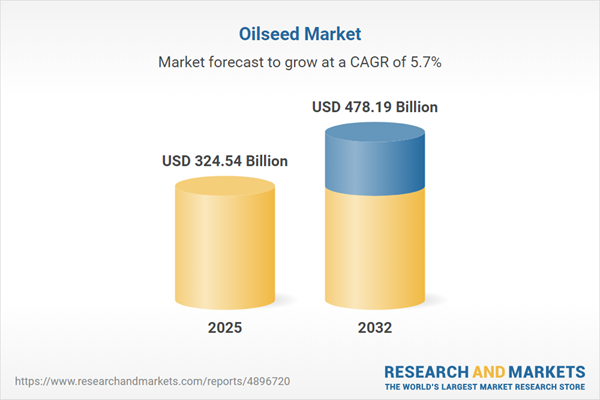Speak directly to the analyst to clarify any post sales queries you may have.
The global oilseed market is undergoing accelerated transformation as new regulations, technological advancements, and shifting customer priorities demand greater strategic clarity and adaptability from executive teams. Navigating this evolving landscape requires a nuanced understanding of emerging risks and opportunities.
Market Snapshot: Oilseed Market Size and Growth Outlook
The oilseed market is on a robust upward trajectory, with a forecasted value of USD 307.01 billion in 2024, expected to rise to USD 324.54 billion by 2025. By 2034, the market is projected to reach USD 478.19 billion, reflecting a compound annual growth rate (CAGR) of 5.69%. Market momentum is fueled by investments in plant-based proteins, expanding specialty oils sectors, and heightened renewable fuel initiatives. Ongoing modifications in regulatory frameworks, along with evolving buyer preferences, are prompting manufacturers and supply chain operators to adapt, resulting in greater industry competition and innovation.
Scope & Segmentation of the Oilseed Market
This comprehensive report provides executives with clear segmentation and actionable insights across the oilseed market value chain, essential for effective decision-making and resource allocation:
- Oilseed Types: Canola, peanut, soybean, and sunflower, each supporting diverse applications in food, animal feed, and industrial sectors, with their allocation strategies affecting supply chain efficiencies worldwide.
- Product Forms: Crude oils, animal nutrition hulls, hydrogenated oils, RBD oils, virgin oils, and other oilseed derivatives designed to meet demand for wellness-focused and clean-label products.
- Processing Technologies: Cold pressing, enzymatic extraction, expeller pressing, and solvent-based methods, each improving oil yield, product quality, and traceability standards.
- Applications: Used in livestock and aquaculture feed, pet nutrition, food processing, biodiesel, lubricants, detergents, and personal care, supporting commercial diversification of oilseed-derived ingredients.
- Distribution Channels: Includes traditional retail, supermarkets, specialty stores, hypermarkets, and online commerce, highlighting the adaptation of procurement methodologies to changing market dynamics.
- Regions Covered: In-depth analysis of the Americas, Europe, Middle East & Africa, and Asia-Pacific regions, with attention to varying regulatory environments and agricultural models that influence local market approaches.
- Leading Companies: Highlights strategies and partnerships among Cargill, Archer Daniels Midland, Bunge, Louis Dreyfus Company, Wilmar International, COFCO International, Olam International, Viterra, Marubeni, and GrainCorp, reflecting their roles in shaping competitive dynamics in the oilseed landscape.
Key Takeaways for Strategic Planning
- Traceable sourcing is becoming integral to procurement, branding, and compliance, supporting higher transparency standards and strengthening trust in plant-based protein and specialty oil products.
- Emerging technologies—including digital traceability and advanced extraction methods—are creating new avenues for product differentiation and supporting targeted sustainability and nutritional objectives.
- Closer collaboration across the oilseed value chain is expediting the adoption of innovation in breeding and processing, ensuring greater alignment with local feedstock needs and evolving regulatory goals.
- Oilseed byproducts play a growing role in addressing animal protein demand, particularly in rapidly developing regions, leading to shifts in upstream operations and strategic expansion throughout the agribusiness sector.
- Premiumization and increased purchasing power in key Asia-Pacific markets are prompting organizations to recalibrate channel strategies and pursue broader end-market opportunities.
Tariff Impact and Trade Recalibration
Recent tariff changes in the United States have altered oilseed trade flows, heightening competition in Asian and European markets and contributing to increased price volatility. Many importers and refiners are revisiting logistics strategies by implementing flexible storage solutions and dynamic contract models. Bilateral and customized agreements are also emerging to ensure supply continuity and reduce exposure to shifting regulations.
Methodology & Data Sources
Findings are based on direct interviews with senior market participants, thorough reviews of sector publications, and validated data from proprietary research methods. Systematic triangulation and peer review underpin the reliability and sector relevance of all analysis provided.
Why This Report Matters
- Enables business leaders to adapt operational and strategic plans in response to evolving oilseed market regulations and value chain shifts.
- Supports informed decision-making for capital investments and expansion strategies with detailed regional and segment analysis aligned with sector priorities.
- Delivers technical and commercial teams early visibility into emerging trends in demand, procurement, and advanced oilseed processing, promoting prompt, confident response to market shifts.
Conclusion
This report delivers senior leaders a comprehensive yet accessible overview of regulatory, technological, and regional trends, equipping organizations to remain resilient and competitive within the rapidly changing oilseed sector.
Additional Product Information:
- Purchase of this report includes 1 year online access with quarterly updates.
- This report can be updated on request. Please contact our Customer Experience team using the Ask a Question widget on our website.
Table of Contents
3. Executive Summary
4. Market Overview
7. Cumulative Impact of Artificial Intelligence 2025
Companies Mentioned
The companies profiled in this Oilseed market report include:- Cargill, Incorporated
- Archer Daniels Midland Company
- Bunge Limited
- Louis Dreyfus Company B.V.
- Wilmar International Limited
- COFCO International Limited
- Olam International Limited
- Viterra Inc.
- Marubeni Corporation
- GrainCorp Limited
Table Information
| Report Attribute | Details |
|---|---|
| No. of Pages | 180 |
| Published | November 2025 |
| Forecast Period | 2025 - 2032 |
| Estimated Market Value ( USD | $ 324.54 Billion |
| Forecasted Market Value ( USD | $ 478.19 Billion |
| Compound Annual Growth Rate | 5.6% |
| Regions Covered | Global |
| No. of Companies Mentioned | 11 |









